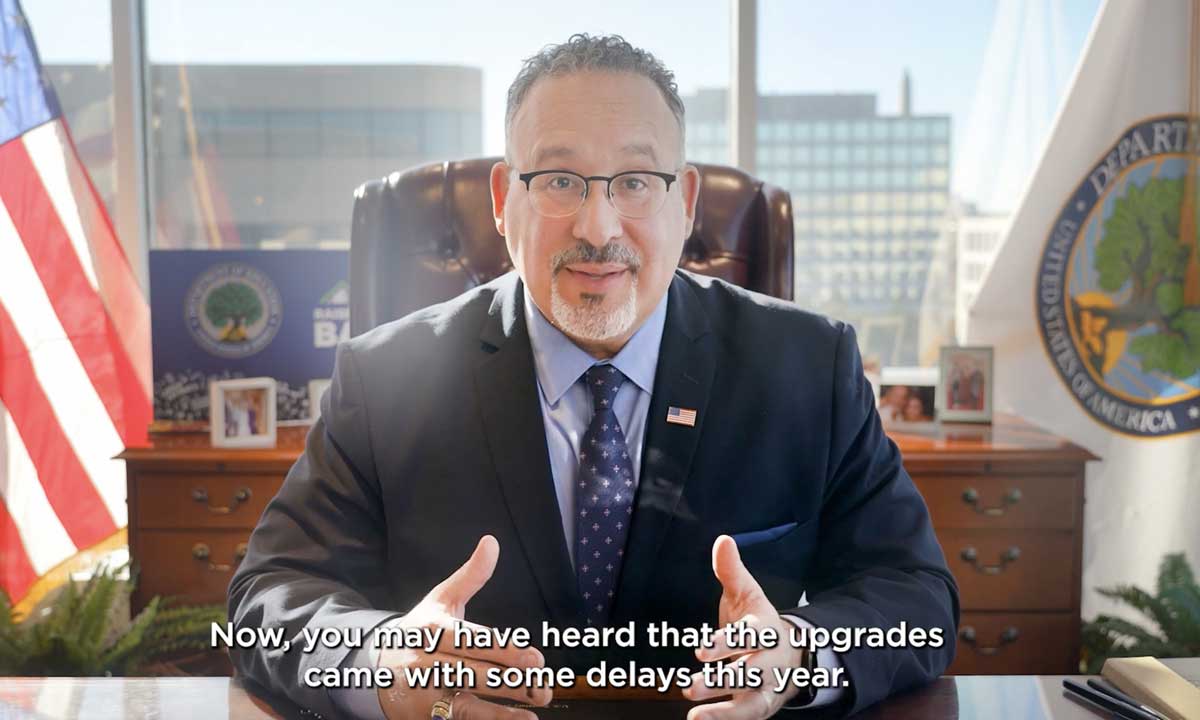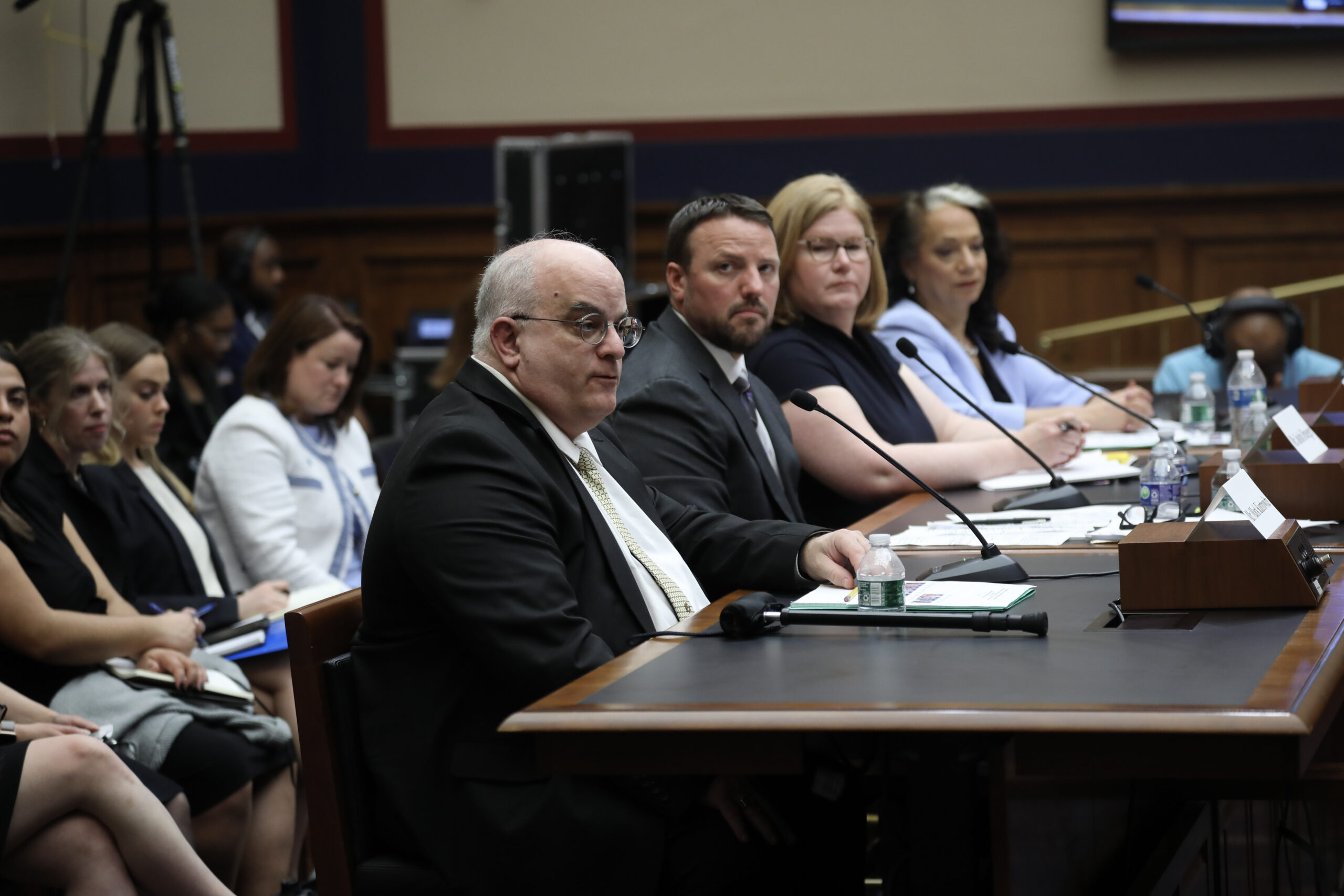Ed Dept. Holds ‘Week of Action’ on Financial Aid, Months After Bungled Rollout
As the end of the school year nears, some worry counselors are running out of time to help students most in need of financial aid.

Get stories like this delivered straight to your inbox. Sign up for The 74 Newsletter
After a clumsy rollout to its revamped financial aid application, one that was supposed to make the process easier, the Biden administration has declared April 15-19 a “week of action” to get anxious students to complete the form.
At Noble Street College Prep, counselors are urging seniors to log into their Free Application for Federal Student Aid, or FAFSA, daily to check on the status. As the U.S. Department of Education scrambles to correct months of mistakes, changes in the system can pop up unexpectedly.
“Updates happen in the middle of the night, sometimes in the middle of class,” said Michelle Ganti, dean of college counseling at the Chicago charter school.

In New York, the school district will join with public libraries to host evening and weekend FAFSA sessions for students and families where they can get help from college representatives and financial aid experts.
Similar FAFSA support activities will be underway nationwide. But is it too little, too late?
A Wednesday House hearing billed as a response to the “FAFSA fail” attracted bitter attention to the department’s missteps from both sides of the aisle.
“We need weeks of action,” said Kim Cook, CEO of the National College Attainment Network, told Congress Wednesday. “We’ll have to look for ways to continue to support and access students through the summer.”
Education Department officials say they “will continue to listen and be responsive to groups and advocates … who are helping students and families navigate the challenges.”
They’re encouraging more in-person events as well as email campaigns and text reminders to nudge families to submit the FAFSA. The concerted effort might boost completion rates, which are still down 40% compared with last year. But with this year’s application process beset by delays and miscalculations, experts — and educators already helping students navigate the chaos — aren’t convinced everything will go smoothly. And they say time is short to get the neediest students the assistance they need.
“It’s hard for all of us not to be cynical in front of families and to really stay as positive as possible,” said Kim Nauer, a financial aid expert at The New School in New York. She’s in constant communication with counselors across the city and runs a website to keep families updated on the ever-changing situation. Case in point: As she spoke to a 74 reporter Thursday, the FAFSA website began allowing users to make corrections on their forms for the first time.

Those hardest hit by the delays include students who are likely to opt out of college altogether this year and institutions that might have to close because they rely on low-income students who depend on federal Pell grants.
Experts are also increasingly worried that aftershocks of the debacle could be felt for years to come — starting with the next financial aid cycle for the 2025-26 academic year.
In a normal year, the department would have released a paper version of the form by now to allow the public to comment on changes before the new application opens Oct. 1. While the modifications won’t be as drastic as this year’s, there are typically some wording changes. But with officials tied up trying to get corrected financial information to students and colleges for this fall, that new form isn’t out yet, potentially creating another time crunch for next year’s seniors.
Mark Kantrowitz, who leads a financial aid consulting firm, told members of the higher education subcommittee Wednesday that he “[lacks] confidence” the department will be able to get the process back on track.
‘Moving full speed’
In a statement, a spokesperson said the department’s Federal Student Aid office “has prioritized the overhaul of the FAFSA form and has been moving full speed to implement the bipartisan law to make this experience far better for those completing the form.” On Monday, Deputy Secretary Cindy Marten will participate in a FAFSA webinar for families, hosted by the National Parents Union.
The series of failures began last October when the department was unable to make what the administration renamed a “Better FAFSA” ready for the typical application window. In a “soft launch,” the form became available in December, but technical glitches prevented many students from completing it, particularly those with undocumented parents who lack social security numbers.
In February, the department released a “workaround” designed to allow parents affected to complete their portion, but Nauer, in New York, said, “In order to know that that seven-page sheet exists, you have to have a counselor who’s telling you about it.”
Republicans, and some Democrats, were further outraged in January when the department pushed back until March the date to send students’ financial information to colleges, giving them far less time to turn around financial aid offers before deciding which school to attend — a deadline that typically falls on May 1.. Even then, some of the data was wrong, keeping families and schools in limbo.
On Tuesday, the department’s Federal Student Aid office updated the extent of the damage and detailed officials’ attempts to undo it. Students need to make corrections on roughly 16% of applications. Processing errors are affecting about 30% of the forms, and about 20% require corrected tax information from the IRS.
Rachelle Feldman, vice provost of enrollment at the University of North Carolina at Chapel Hill, spelled out the consequences of the delays during this week’s hearing.
“I really worry that we will lose the lowest-income, high-talent students, that they’ll choose not to enroll in college,” she told Democratic Rep. Alma Adams of North Carolina. “That will be bad for the entire economic and social mobility of our state.”
‘An incredible strain’
The troubled application period comes as college enrollment rates continue to reel from the pandemic, when the number of undergraduates entering colleges and universities declined by 7%. In her comments, Cook expressed concern that this year’s drop could be just as dramatic, and said a million more high school seniors nationally would need to complete applications by June 30 to hit last year’s submission rate.
With the end of the school year just weeks away in some parts of the country, she stressed time was limited to help students whose forms are incomplete or need corrections. “Time really has to be well spent with the students that we still have access to,” she said.
At North County Union High School in Newport, Vermont, just south of the Canadian border, that works out to about 170 seniors, including many who would be the first in their families to go to college.
Counselors from the Vermont Student Assistance Corp.’s GEAR UP program have worked to help students get over the hurdles in this year’s process, said Principal Chris Young.
“But my biggest concern is that they just are going to give up,” he said. Even “very well-educated families” can’t make decisions about which admission offers to accept, he said. “It’s an incredible strain on families.”
He said about 70% of his school’s seniors typically go to college, with most attending schools in Vermont and Maine and some heading south to warmer climates in the Carolinas or Florida. For about one-tenth of those students, financial aid offers determine not which school they’ll attend, but whether they’ll go at all.
One harried student came to him recently, saying he thought he’d been able to complete the form without a hitch. Then, Young added, “he realized he’d filled out last year’s.”
Get stories like these delivered straight to your inbox. Sign up for The 74 Newsletter

;)
